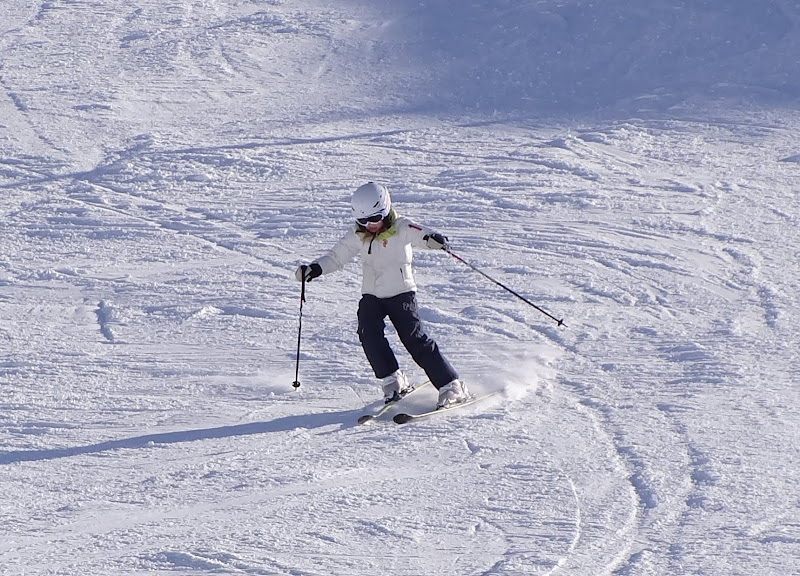Emily had been skiing all morning in a small group but after refuelling at lunch time she was raring to go for the afternoon. My attention was mainly focussed on Sophie this session but Emily enjoyed skiing on one leg and was able to understand some of the explanations I was giving for Sophie’s benefit. Emily’s skiing today is more fluid and confident – more oriented on one leg and a bit less rushed at the start of the turns as a result. Regardless of Emily’s confidence it’s probably Sophie who has made the biggest changes – much stronger dynamics, much rounder turns and pressure on the outside ski all the way through the turns.
Emily with a strong stance on one leg, with some hip angulation showing but not enough dynamics. The leg tends to be pushed out and away from the body instead of the body (centre of mass) moving inwards.
Sophie with good dynamics leading to effective body inclination and a strong support on the outside ski. Once this is consolidated then some more hip angulation needs to be developed.
Dynamics
For Sophie today it was the occasion to clarify dynamics and remove any lingering confusion. It’s normal to find this subject confusing – phenomena based on gravity were never understood correctly until the genius of Galileo came along. Aristotle got it all wrong and so did all of Western education for the following 2000 years. I helped Sophie to feel the sensations though supporting her through some exercises and then to have a picture of a bicycle or motorbike to give a visual image. I also changed her concept of “uphill” and “downhill” skis to “outside” and “inside” for during a turn. All of this together brought results.
Dynamics generates a natural down/up timing as the skier tilts over into a turn and then comes back up at the end. This is the opposite of the up/down timing taught initially by ski schools. That down/up timing creates a skating pressure cycle against the legs and because of this the legs can be used actively in a skating action without it even being visible. Skating adds energy and power to a turn for several reasons. (changing pressure and edge angles through muscular impulse and changing body shape) This pressure cycle is essential for smooth turning and reducing shocks on the body and joints. The function of the leg (skating) and dynamics is natural and the pressure cycle ensures correct reflexes which protect the body from trauma and trigger automatic and supportive involuntary muscular actions including postural support. Most of the body’s proprioceptors (6th sense for positioning in space) are in the feet so the right pressure cycle is extremely important.



No comments:
Post a Comment